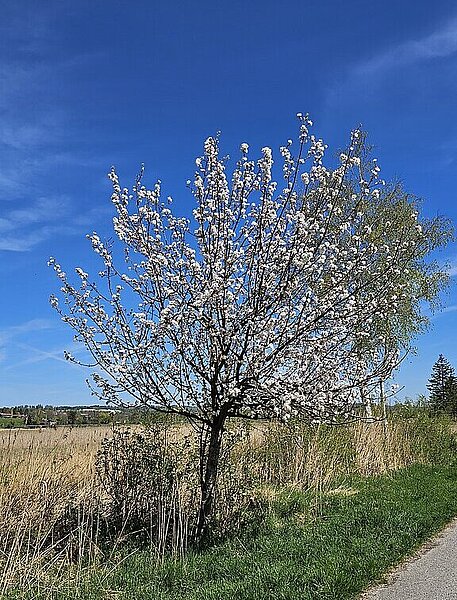Cherry tree

A look at the cherry tree
The cherry tree, known for its sweet or sour fruit, belongs to the rose family (Rosaceae). It is not only popular for its fruit, but also for its impressive blossom, which marks the beginning of spring. But what makes it special from a botanical point of view, and which parts could be potentially dangerous for dogs?
The hidden dangers in the cherry tree
Leaves and twigs
Less well known is that the leaves and twigs of the cherry tree can contain substances such as cyanide, especially when they wilt. These can be toxic to dogs and if ingested can lead to symptoms such as shortness of breath, increased salivation, weakness and in severe cases even death.
Pits, stems and blossoms
The pits of cherries also contain cyanide, similar to the pits of other stone fruits. The stems and blossoms of the cherry tree also pose a risk, albeit to a lesser extent. It is therefore advisable to prevent dogs from having access to these parts of the tree.
The fruit: a double-edged sword
The fruit of the cherry tree itself is not poisonous to dogs in small quantities. However, as already mentioned, the pits can be dangerous. There is also a risk of intestinal blockage, especially in small dogs, if they swallow whole cherries, including the pits.
Prevention and first aid
It is important to take precautions to avoid exposure to the dangerous parts of the cherry tree. Keep your dog away from fallen leaves, branches and fruit of the tree. If your dog has consumed any part of the cherry tree, it is crucial to seek veterinary help immediately. Symptoms of poisoning can vary and range from mild to severe.
The cherry tree can be both an asset to the garden and a potential danger to dogs. While the fruit is safe in moderation, other parts of the tree pose a serious risk. The best way to ensure your dog's health and safety is to keep him away from these hazards and act quickly if you suspect a hazard. In this way, the cherry tree can remain a valued part of our environment without becoming the enemy of our four-legged friends.
If you notice any signs of hypersensitivity or poisoning in your dog, you should see your vet immediately. We are not a substitute for a vet, but we try to be as accurate as possible. Every dog reacts differently and we recommend you get a second opinion or consult your vet if in doubt.
Stay healthy and take good care of your four-legged friend!😊
Similar to Cherry tree
Let's start with the most obvious part: the peach fruit. The flesh of the peach is generally safe for dogs in moderation. It is rich in vitamins and can be a healthy addition to the diet. However,...
The apricot tree (Prunus armeniaca) is a fruit tree from the Rosaceae family that is known for its edible fruit. The apricot, the fruit of the tree, is rich in vitamins, minerals and fiber. While...
The plum tree (Prunus domestica) belongs to the rose family (Rosaceae) and is known for its tasty fruit. However, to ensure the safety of our dogs, it is important to look closely at all parts of...
The pear tree (Pyrus communis) is a widespread fruit tree known for its sweet and juicy fruit. In addition to its role in fruit production, the pear tree also plays an important ecological role by...



